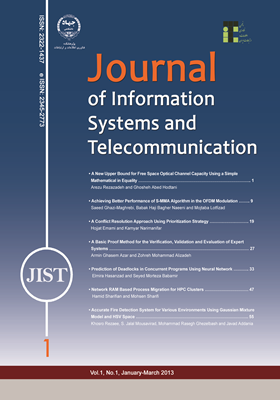-
-
List of Articles
-
Open Access Article
1 - A New Upper Bound for Free Space Optical Channel Capacity Using a Simple Mathematical in Equality
Arezu Rezazadeh Ghosheh Abed Hodtani -
Open Access Article
2 - Achieving Better Performance of S-MMA Algorithm in the OFDM Modulation
Saeed Ghazi-Maghrebi Babak Haji Bagher Naeeni Mojtaba Lotfizad -
Open Access Article
3 - A Conflict Resolution Approach using Prioritization Strategy
Hojjat Emami Kamyar Narimanifar -
Open Access Article
4 - A Basic Proof Method for the Verification, Validation and Evaluation of Expert Systems
Armin Ghasem Azar Zohreh Mohammad Alizadeh -
Open Access Article
5 - Prediction of Deadlocks in Concurrent Programs Using Neural Network
Elmira Hasanzad babamir babamir -
Open Access Article
6 - Network RAM Based Process Migration for HPC Clusters
Hamid Sharifian msharifi msharifi -
Open Access Article
7 - Accurate Fire Detection System for Various Environments using Gaussian Mixture Model and HSV Space
Khosro Rezaee Seyed Jalaleddin Mousavirad Mohammad Rasegh Ghezelbash Javad Haddadnia
-
The rights to this website are owned by the Raimag Press Management System.
Copyright © 2017-2025







